The recent warning by Professor Hans Joachim Schellnhuber, Director of the Potsdam Institute of Climate Impact: “We are simply talking about the very life support system of this planet” is consistent with the lessons arising from the history of the Earth’s atmosphere/ocean system.
A rise of CO2-e (CO2-equivalent, including the effect of methane) above 500ppm and of mean global temperature towards and above 4C, projected by the IPCC, Copenhagen and Oxford scientific reports, as well as reports by the world’s leading climate science bodies (NASA/GISS, Hadley-Met, Potsdam Climate Impact Institute, NSIDC, CSIRO, BOM), would transcend the conditions which allowed the development of agriculture in the early Neolithic, tracking towards climates which dominated the mid-Pliocene (3 Ma) (1 Ma = 1 million years) and further toward greenhouse Earth conditions analogous to those of the Cretaceous (145-65 Ma) and early Cenozoic (pre-34 Ma).
Lost all too often in the climate debate is an appreciation of the delicate balance between the physical and chemical state of the atmosphere-ocean-land system and the evolving biosphere, which controls the emergence, survival and demise of species, including humans.
Advertisement
By contrast to Venus, with its thick blanket of CO2 and sulphur dioxide greenhouse atmosphere, exerting extreme pressure (90 bars) at the surface, or Mars with its thin (0.01 bar) CO2 atmosphere, the presence in the Earth’s atmosphere of trace concentrations of greenhouse gases (CO2, methane, nitric oxides, ozone) modulates surface temperatures in the range of -89 and +57.7 degrees Celsius, allowing the presence of liquid water and thereby of life.
Forming a thin breathable veneer only slightly more than one thousandth the diameter of Earth, and evolving both gradually as well as through major perturbations with time, the Earth’s atmosphere acts as the lungs of the biosphere, allowing an exchange of carbon gases and oxygen with plants and animals, which in turn affect the atmosphere, for example through release of methane and photosynthetic oxygen.
Any significant increase in the level of carbon gases triggers powerful feedbacks. These include ice melt/warm water interaction, decline of ice reflection (albedo) effect and increase in infrared absorption by exposed water. Further release of CO2 from the oceans and from drying and burning vegetation shifts of global climate zones toward the poles, warms the oceans and induces ocean acidification.
The essential physics of the infrared absorption/emission resonance of greenhouse molecules has long been established by observations in nature and laboratory studies, as portrayed in the relations between atmospheric CO2 and mean global temperature projections in Figure 1.

Figure 1
A plot of global mean temperature (increase above pre-industrial time in degrees C) vs atmospheric greenhouse gas (GHG) concentration (in CO2-eqivalent, a value which includes the effect of methane).
The assumed climate is 3+/-1.5 degrees C per doubling of CO2-e. The field I, II, III, etc. correspond to the IPCC’s various emission scenarios. IPCC Climate Change 2007: Synthesis Report, figure 5.1.
Advertisement
The living biosphere, allowing survival of large mammals and of humans on the continents, developed when CO2 levels fell below about 500ppm some 34 million years ago (late Eocene). At that stage, and again about 15 million years ago (mid-Miocene), development of the Antarctic ice sheet led to a fundamental change in the global climate regime.
About 2.8 million years ago (mid-Pliocene) the Greenland ice sheet and the Arctic Sea ice began to form, with further decline in global temperatures expressed through glacial-interglacial cycles regulated by orbital forcing (Milankovic cycles), with atmospheric CO2 levels oscillating between 180 and 280ppm CO2. These conditions allowed the emergence of humans in Africa and later all over the world.
Humans already existed 3 million years-ago, however these were small clans which, in response to changing climates migrated to more hospitable parts of Africa and subsequently Asia. About 124,000 years ago, during the Emian interglacial, temperatures rose by about 1 degree C and sea levels by 6 to 8 meters.
The development of agriculture and thereby human civilisation had to wait until climate stabilised about 8,000 years ago, when large scale irrigation along the great river valleys (the Nile, Euphrates, Hindus and Yellow River) became possible.
Since the industrial revolution humans dug, pumped and burnt more than 320 billion tons of carbon which accumulated as the result of biological activity during 400 million years: 320 billion tons of carbon is more than 50 per cent the carbon concentration of the original atmosphere (540 billion tons). As a consequence the level of CO2 in the atmosphere has risen by about 40 per cent, from 280 to 388ppm.
The world is now witnessing a dangerous shift in the state of the atmosphere-ocean system, an extremely rapid change from the interglacial condition of the Holocene, which began about 11,700 years-ago, to conditions analogous to those of the mid-Pliocene when mean global temperatures were 2 to 3 degrees C higher, and sea levels about 25+/-12 meters higher, than the early 20th century.
In terms of the combined effects of CO2, methane and nitric oxide, the rise of greenhouse gases has reached about 460ppm CO2-equivalent (CO2-e) (Figure 1), only slightly below the 500ppm level which correlates with the maximum stability of the Antarctic ice sheet.
The current rate at which CO2 is rising, 2ppm per year, is unprecedented in the recent history of the Earth, with the exception of the onset of greenhouse atmospheric conditions following major volcanic episodes and asteroid and comet impacts, which led to the large mass extinctions in the history of the Earth (end-Ordovician, end-Devonian, end-Permian and Permian-Triassic boundary, end-Triassic, end-Jurassic, end-Cretaceous) (Figure 2).

Figure 2
Variations in atmospheric CO2 concentrations and oxygen concentrations correlated with ice ages (blue histograms, extending according to geographic latitude). Note the sharp decline in atmospheric CO2 during ice ages.
After Royer et al. 2004 (CO2 as a primary driver of Phanerozoic climate. GSA Today; v. 14; no. 3) and Berner et al. 2007.
Further rise of CO2-e above 500ppm and mean global temperatures above 4 degrees C can only lead toward greenhouse Earth conditions such as existed during the Cretaceous and early Cenozoic (Figure 2).
At 4 degrees C advanced to total melting of the Greenland and Antarctic ice sheets leads to sea levels tens of meters higher than at present.
Since the 18th century mean global temperature has risen by about 0.8 degrees C. Another 0.5 degrees C is masked by industrial-emitted aerosols (SO2), and further rise ensues from current melting of the ice sheets and sea ice, with loss of reflection (albedo) of ice and gain in infrared absorption by open water, leading to feedback effects.
The polar regions, acting as the “thermostats” of the Earth, are the source of the cold air current vortices and the cold ocean currents, such as the Humboldt and California current, which keep the Earth’s overall temperature balance, much as the blood stream regulates the body’s temperature and the supply of oxygen.
Unfortunately climate change is not an abstract notion, with consequences manifest around the globe in terms of:
- polar ice melt;
- sea level rise;
- migration of climate zones toward the poles;
- desertification of temperate climate zones;
- intensification of hurricanes and floods, related to increase in the level of atmospheric energy;
- acidification of the oceans; and
- destruction of coral reefs.
Which is why the European Union and in recent international conferences defined a rise by 2.0 degrees C as the maximum permissible level. A dominant scientific view has emerged that atmospheric CO2 levels, currently at 388ppm, need to be urgently reduced to below 350ppm. This is because, a rise of CO2 concentration above 350ppm triggers feedback effects, which include:
- carbon cycle feedback due to warming, which dries and burns vegetation, with loss of CO2. With further warming, the onset of methane release from polar bogs and sediments is of major concern; and
- ice/melt water interaction feedbacks: melt water melts more ice, ice loss results in albedo loss, exposed water absorb infrared heat.
Because CO2 is cumulative, with atmospheric residence time on the scale of centuries to millennia, it may not be possible to stabilise or control the climate through small incremental reduction in emissions and avoid irreversible tipping points.
Humans can not argue with the physics and chemistry of the atmosphere. Time is running out. What is needed are global emergency measures, including:
- urgent deep cuts in carbon emissions by as much as 80 per cent;
- parallel Fast track transformation to non-polluting energy utilities - solar, solar-thermal, wind, tide, geothermal, hot rocks; and
- global reforestation and re-vegetation campaigns, including application of biochar.
Business as usual, with its focus on the annual balance sheet, can hardly continue under conditions of environmental collapse. Governments, focused on the next elections, need to focus on the survival of the next generation
Good planets are hard to come by.